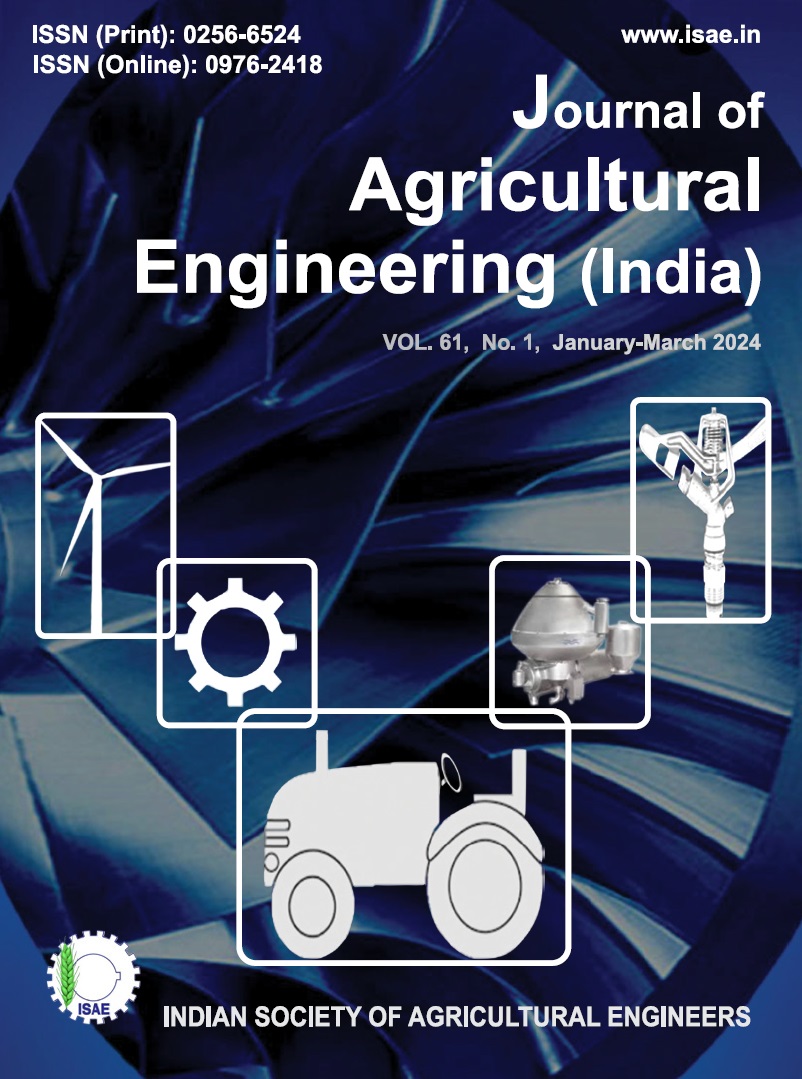Mechanics of Paddy Plant for Direct Ear-head Threshing and Optimization of Grain Loss
DOI:
https://doi.org/10.52151/jae2024611.1834Keywords:
Broken loss, panicle breaking force, plant uprooting force, shattering loss, straw breaking forceAbstract
In developed direct ear-head thresher, grain bearing portion of standing plants is placed over the threshing cylinder. On this portion, upward tensile force is exerted by the threshing elements of rotating cylinder. Consequently, grains and panicles detach from the plant. The breakage of straw or uprooting of entire plants may also occur when the force is transmitted to them. The action is dependent on the strength of the plant straw and root grip. The panicle breaking, straw breaking and plant uprooting forces were determined. The average of these forces was 68.4, 134 and 509 N, respectively. The plant should remain erected and its panicle base should be above the height of cylinder axis to get efficient threshing. The average height of panicle base was 62 cm and accordingly, the cylinder axis was fixed at 60 cm to minimize the grain losses. The shattering, broken and un-threshed grain loss were 3.61, 0.11 and 1.07%, respectively, at optimized speeds of cylinder and plant feeding of 18.94 m.s-1 and 0.8 km.h-1. There was a significant effect of VP and VF on the grain loss. The threshing of only ear-heads minimizes the power requirements. It was found to vary from 0.1 to 0.35 kW.
References
Barik, S R; Pandit E; Pradhan S K; Mohanty S P; Mohapatra T. 2019. Genetic mapping of morpho-physiological traits involved during reproductive stage drought tolerance in rice. PLoS One, 14 (12), e0214979. https://doi.org/10.1371/journal.pone.0214979 .
Chegini G R. 2013. Determination of Optimum Operating Conditions of Combine Harvester with Stripper-Header. World Applied Sci. J., 23(10), 1399-1407. https://doi.org/10.5829/idosi. wasj.2013.23.10.1829 .
Galedar M N; Tabatabaeefar A; Jafari A; Sharifi A; Rafiee S; Mohtasebi S S. 2009. Influence of moisture content, rate of loading and height regions on tensile strength of alfalfa stems. Int. Agrophysics, 23(1), 27-30.
Listner G; Axmann M. 1993. Harvesting Grain with Less Straw. Current Status and Perspectives. Land technique (Germany). Eng. Translation. 48, 115-118.
Miu, P. 2015. Introduction to Combine Harvesters. In Combine Harvesters: Theory, Modeling, and Design. CRC Press. Taylor and Francis Group. 1-54, https://doi.org/10.1201/b18852 .
Naik R K; Patel S; Verma A K; Shrivastava A K. 2010. Effect of crop and machine parameters on performance of paddy thresher. Agric. Eng. Today, 34(1), 30-32.
O'Toole J C; Maguling M A; Vaivananda N. 1980. A Simple Method to Characterize Rice Root Systems in Relation to Drought Resistance. Int. Rice Res. Newsletter, 5(4), 9-10. https://doi.org/10.1007/BF00033989
Parihar D S; Shrivastava A K; Awasthi V. 2022. Effect of machine and crop parameters on paddy (Oryza sativa) threshing using axial flow thresher. J. Agric. Eng., 59(3), 229-239. https://doi.org/10.52151/jae2022593.1778.
Sahu S K; Thomas E V. 2021, Design and Development of a Single Row Mechanical Paddy Harvester, Published PhD Thesis, Agricultural and Food Engineering Department, IIT Kharagpur 78-126. Available at: http:// www.idr.iitkgp.ac.in/xmlui/handle/123456789/11774 (accessed on 14 Mrach 2024).














